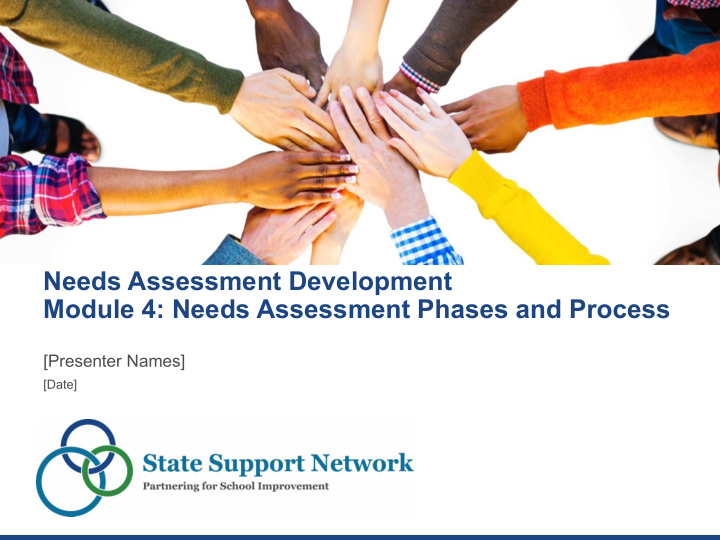



Needs Assessment Development Module 4: Needs Assessment Phases and Process [Presenter Names] [Date]
2 About us: [Insert name and role of facilitator and supporting organization here] 2
Meet the Presenters Name Name Name Title Title Title email email email 3
What Will the Overall Needs Assessment Development Process Look Like? Module 1: Purpose Module 2: Lessons Learned Module 3: Content Module 4: Process Module 5: Presentation 4
Outcomes As a result of this module, participants will be able to do the following: • Identify activities for each of the needs assessment implementation phases. • Establish roles and responsibilities at school, district, and State education agency levels. • Draft a sequence of activities. 5
Agenda, Module 4 Welcome, Overview, and Introductions 1. Planning the Needs Assessment Process 2. Journey Mapping: Laying Out the Process 3. Reflect on Module and Next Steps 4. 6
Ice Breaker Placeholder for icebreaker/introductions activity. 7
Norms for Interaction • Be present. • Share the air. • Assume goodwill. • Respect what is shared. • Honor the thoughts behind all perspectives. • Ask for clarification when you disagree or don’t understand. • Others? 8
Planning the Needs Assessment Process 9
Needs Assessment as a Project What does it look like to implement the needs assessment project at the State or district level? 10
Needs Assessment as a Project Project Management Phases – [ State or district] Initiate Plan Execute Control Close Phases of a Needs Assessment - School Collecting and Interpreting Determining Connecting to Planning Organizing Data Information Priorities Implementation 11
Needs Assessment Phases What does it look like to implement a needs assessment at the school level? 12
Needs Assessment Phases Collecting Connecting and Interpreting Determining to Planning Organizing Information Priorities Implement- Data ation 13
Hey, this Planning happened in Module 1! • Articulate the purpose and intended outcomes. • Define your content, process, presentation. • Determine central guiding questions that the needs assessment should address. • Identify relevant stakeholders. Planning 14
Collecting and Organizing Data • Organize readily available data from existing sources. • Determine and collect additional needed data. • Decide on presentation of data. Collecting and Organizing Data 15
Interpreting Information • Uncover what individual data sources say about guiding questions. • Crystallize themes. • Investigate areas of stakeholder disagreement and causes of disagreement. • Articulate findings for stakeholders without casting blame. Interpreting Information 16
Determining Priorities • Conclude what findings and themes will have the greatest impact (if addressed). • Contemplate whether there are additional data that should be reviewed. Determining Priorities 17
Connecting to Implementation • Collect additional information about identified priorities. • Investigate root causes of priorities. • Use results to create meaningful, long-term change. • Reflect on the progress of improvement efforts. Connecting to Implementation 18
Implementation Path Activity 19
Sample Wall Chart Implementation Path 20
Brainstorming Milestones and Activities 1. WORK SILENTLY! 2. Generate activities or milestones on sticky notes—color coded by group. 3. Place sticky notes on path. 21
As a Large Group 1. STILL WORK SILENTLY! 2. Review milestones along the path. 3. Move sticky notes as necessary to improve accuracy. 4. Identify additional milestones and activities as needed to fill out. 5. Make notes and ask questions directly on paper with markers. 22
Reflect on Module and Next Steps 23
Implementation Map Reflection • As you look at the completed map, what stands out to you? • What questions does this raise for you? • How does the implementation path you created affect your thinking about timelines? • How have today’s activities increased your understanding of the needs assessment? 24
Next Steps Continue the work we started today: • Assign a timeline to the implementation path. • Capture the roles, responsibilities, and milestones articulated here. • Make note of additional tasks, responsibilities, and/or questions that arise as you capture this work. 25
Next Steps: What Happens at the School Level? How is a school community engaging in this work? • Local data collection • Stakeholder engagement – who, how, when? • Data presentation • Data analysis • Collaborative identification of improvement needs • Connecting to implementation https://statesupportnetwork.ed.gov/resources/needs- assessment-guidebook 26
Module 5: Presentation As a result of this module, participants will be able to do the following: • Determine how the needs assessment materials will be formatted and disseminated. • Describe how the needs assessment will be implemented. • Draft a plan for supporting implementation. 27
Recommend
More recommend